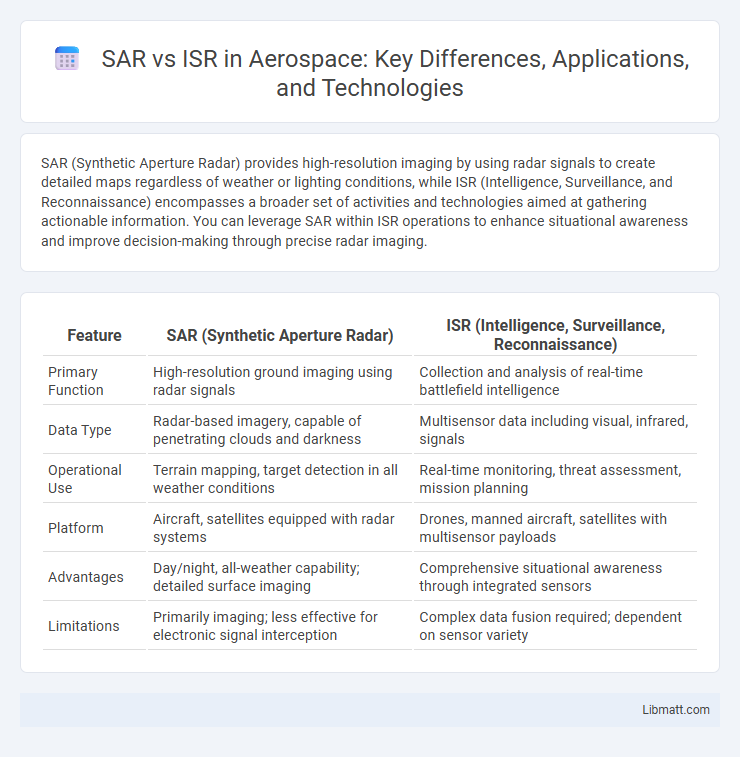SAR (Synthetic Aperture Radar) provides high-resolution imaging by using radar signals to create detailed maps regardless of weather or lighting conditions, while ISR (Intelligence, Surveillance, and Reconnaissance) encompasses a broader set of activities and technologies aimed at gathering actionable information. You can leverage SAR within ISR operations to enhance situational awareness and improve decision-making through precise radar imaging.
Table of Comparison
| Feature | SAR (Synthetic Aperture Radar) | ISR (Intelligence, Surveillance, Reconnaissance) |
|---|---|---|
| Primary Function | High-resolution ground imaging using radar signals | Collection and analysis of real-time battlefield intelligence |
| Data Type | Radar-based imagery, capable of penetrating clouds and darkness | Multisensor data including visual, infrared, signals |
| Operational Use | Terrain mapping, target detection in all weather conditions | Real-time monitoring, threat assessment, mission planning |
| Platform | Aircraft, satellites equipped with radar systems | Drones, manned aircraft, satellites with multisensor payloads |
| Advantages | Day/night, all-weather capability; detailed surface imaging | Comprehensive situational awareness through integrated sensors |
| Limitations | Primarily imaging; less effective for electronic signal interception | Complex data fusion required; dependent on sensor variety |
Introduction to SAR and ISR
Synthetic Aperture Radar (SAR) is a radar imaging technology that captures high-resolution, two-dimensional images regardless of weather or lighting conditions by using the motion of the radar antenna over a target area. Intelligence, Surveillance, and Reconnaissance (ISR) encompasses a broader set of activities aimed at gathering, analyzing, and distributing information to support military or security operations with real-time situational awareness. Your understanding of SAR enhances ISR capabilities by providing critical data that complements other sensor inputs, enabling more effective decision-making.
Defining SAR: Search and Rescue
Search and Rescue (SAR) operations involve locating and providing assistance to people in distress or imminent danger, often in challenging environments like mountains, oceans, or disaster zones. SAR missions utilize various technologies including satellites, aircraft, and ground teams to detect and reach survivors quickly. Effective SAR integrates real-time data and coordination to optimize response times and save lives during emergencies.
What is ISR: Intelligence, Surveillance, and Reconnaissance
Intelligence, Surveillance, and Reconnaissance (ISR) encompasses the systematic collection and analysis of data to support informed military and strategic decisions. ISR integrates various platforms, sensors, and technologies to gather real-time information on enemy movements, terrain, and environmental conditions. By leveraging ISR, you enhance situational awareness, enabling precise targeting and improved operational effectiveness.
Core Objectives: SAR vs ISR
SAR (Search and Rescue) focuses on locating and aiding individuals in distress or danger, prioritizing rapid response and recovery to save lives. ISR (Intelligence, Surveillance, and Reconnaissance) aims to gather actionable information through monitoring and analysis, supporting strategic decision-making and operational planning. Your mission's success depends on understanding these core objectives, as SAR emphasizes immediate humanitarian assistance while ISR concentrates on information dominance.
Key Technologies in SAR and ISR
Synthetic Aperture Radar (SAR) leverages advanced radar signal processing, motion compensation algorithms, and coherent integration techniques to create high-resolution images regardless of weather or lighting conditions. Intelligence, Surveillance, and Reconnaissance (ISR) systems integrate multi-sensor data fusion, real-time data analytics, and autonomous platforms to enhance target detection, tracking, and situational awareness across diverse operational environments. Both SAR and ISR rely heavily on cutting-edge hardware such as phased-array antennas and sophisticated software frameworks for data interpretation and decision support.
Operational Environments and Applications
Synthetic Aperture Radar (SAR) excels in all-weather, day-and-night operational environments, providing high-resolution imaging in challenging conditions such as dense clouds, rain, and smoke. Intelligence, Surveillance, and Reconnaissance (ISR) systems leverage multiple sensors including electro-optical, infrared, and signals intelligence to support dynamic battlefield awareness, targeting, and threat detection across diverse terrains. SAR is particularly effective for maritime surveillance and terrain mapping, whereas ISR integrates multi-source data for comprehensive situational awareness in military operations and border security.
Data Collection and Analysis Methods
Synthetic Aperture Radar (SAR) collects high-resolution imaging data by emitting microwave signals and analyzing the echoes reflected from surfaces, enabling detailed observation regardless of weather or lighting conditions. Intelligence, Surveillance, and Reconnaissance (ISR) integrates multiple data collection methods such as electro-optical sensors, signals intelligence, and human intelligence to provide comprehensive situational awareness. Advanced data analysis techniques in SAR utilize interferometry and polarimetry for precise terrain mapping, while ISR leverages data fusion and machine learning algorithms to synthesize information for real-time decision-making.
Collaborative Roles: SAR and ISR Integration
SAR (Search and Rescue) and ISR (Intelligence, Surveillance, and Reconnaissance) integration enhances mission effectiveness through real-time data sharing and coordinated operations. ISR provides critical situational awareness and target identification that directly supports SAR efforts by optimizing resource deployment and improving response times. Leveraging ISR technology, your SAR teams can achieve higher precision in locating and assisting individuals in distress.
Challenges and Limitations
Synthetic Aperture Radar (SAR) faces challenges such as speckle noise and limited resolution in dense urban environments, which complicate image interpretation and target identification. Intelligence, Surveillance, and Reconnaissance (ISR) systems encounter limitations in real-time data processing due to vast data volumes and bandwidth constraints, impacting timely decision-making. Both SAR and ISR technologies require advanced algorithms and integration strategies to overcome environmental interference and ensure operational effectiveness.
Future Trends in SAR and ISR
Future trends in Synthetic Aperture Radar (SAR) and Intelligence, Surveillance, and Reconnaissance (ISR) emphasize enhanced real-time data processing, improved resolution through advanced sensor technologies, and the integration of AI-driven analytics for quicker decision-making. You can expect increased deployment of small satellites and drones equipped with SAR and ISR capabilities, enabling persistent global coverage and multi-domain situational awareness. These advancements will revolutionize defense, disaster response, and environmental monitoring by providing more accurate, timely, and actionable intelligence.
SAR vs ISR Infographic

 libmatt.com
libmatt.com